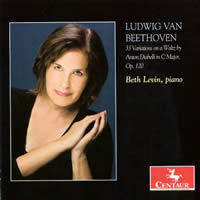The Thirty-Three: Beth Levin
|
Walt Mundkowsky [May 2011.]
Ludwig van BEETHOVEN: 33 Variations on a Waltz by Anton Diabelli in C Major, Op. 120 (1819-23) (rec. live, Settlement Music School, Philadelphia, 11-08-09). Beth Levin (p). Centaur CRC 3046 (http://www.centaurrecords.com/). Distributed in the US by Qualiton (http://www.qualiton.com/). (Street date June 4; ArkivMusic and the label show it now.) Linking the Diabelli Variations to the Goldbergs began with Diabelli himself, but I could find only 15 pianists who’ve recorded both, never mind how successfully. Levin joins the clan1 on her second Centaur release. Cutting applause, a 60:19 timing is the third longest Diabelli on my shelf but it develops its own scale — riveting in repose or when executing the knotty passagework at speed. I confess I don’t entirely engage with the piece until Variation VIII, and the slower ones are my favorites. Some glances — Variation VIII: Poco vivace Brendel dubbed this plateau Intermezzo (to Brahms). Levin gets a lovely flow that’s held aloft by upward-reaching figures in the left hand. Variation XIV: Grave e maestoso Slow and gripping — each 64th note registers. Tedium stays away, thanks to Levin’s sure dynamics and an intriguing timbral split in the piano. Variation XX: Andante To Liszt, this was Sphinx. Daringly drawn out and quiet, Levin’s No. XX stops time as it should — until the crude opening of XXI squashes it. Variation XXVI [Piacevole] C major triads and rests. This little variation inspires lots of variation from players. Levin adopts a splendid humorous patter, light and exacting. Variation XXXII: Fuga. Allegro The fugue is majestic — what Brendel must’ve meant in calling it To Handel. Moving to XXXIII’s C major occurs magically, without a break. Variation XXXIII: Tempo di Menuetto, moderato Levin negotiates the back-and-forth between nods to Op. 111 and comic opera with more grace than many. Love that final forte — not overdone. Levin’s detailed map of the journey is here, here and here (though not in the CD booklet). An older Steinway emerges in Peter Karl’s production with appealing quirks intact. As on the pianist’s live Goldbergs, he provides a cohesive sonic image. Audience noise is rarely noticed. I’d pick Diabellis from long ago and far away — Schnabel (1937), Rudolf Serkin (1957), Rosen (1977), Shure (1981), Arrau (1985). Anderszewski broke through in 2001; Levin’s dexterity, temper and wit should likewise gain her many new admirers. This is defiantly not Beethoven’s last major piano work. The rattling (in both senses) four hands recasting of the Grosse Fuge (Op. 134, 1826) was yet to come. _____ 1Arrau, Barenboim, Kong, Koroliov, Nikolayeva, Rangell, Rosen, P. Serkin, Sheppard, Sokolov, Sultan, Swansbourne, Vieru, Vladar, Yudina.
[More Walt Mundkowsky]
[More
Beethoven]
[Previous Article:
Random Noise 28]
[Next Article:
Maestro di Suoni e Silenzi: Necessary Nono 2.]
|
